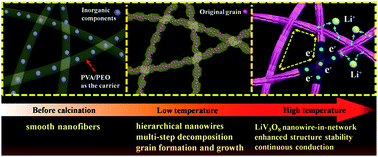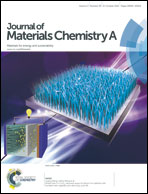An electrospun hierarchical LiV3O8 nanowire-in-network for high-rate and long-life lithium batteries†
Abstract
Structural and morphological control of the LiV3O8 material has a significant impact on its electrochemical performance. In order to obtain a favorable structure, a hierarchical LiV3O8 nanowire-in-network is designed and constructed by electrospinning through a polymer crosslinking strategy. The crosslinking effect between poly(vinyl alcohol) (PVA) and poly(ethylene oxide) (PEO) not only benefits electrospinning, but also realizes a mild multi-step degradation process during calcination. Based on temperature-dependent experiments and thermogravimetric (TG) analysis, the function of polymer blends and the formation mechanism of the structure are discussed in detail. As a cathode for lithium batteries, LiV3O8 exhibits a high initial capacity of 320.6 mA h g−1 at 100 mA g−1 and a high-rate capacity of 202.8 mA h g−1 at 2000 mA g−1. This remarkable performance is attributed to its unique structure, which provides a large effective contact area, low charge transfer resistance, and improved structural stability. Our work indicates that the hierarchical LiV3O8 nanowire-in-network material is a promising cathode for use in high-rate and long-life rechargeable lithium batteries.



 Please wait while we load your content...
Please wait while we load your content...